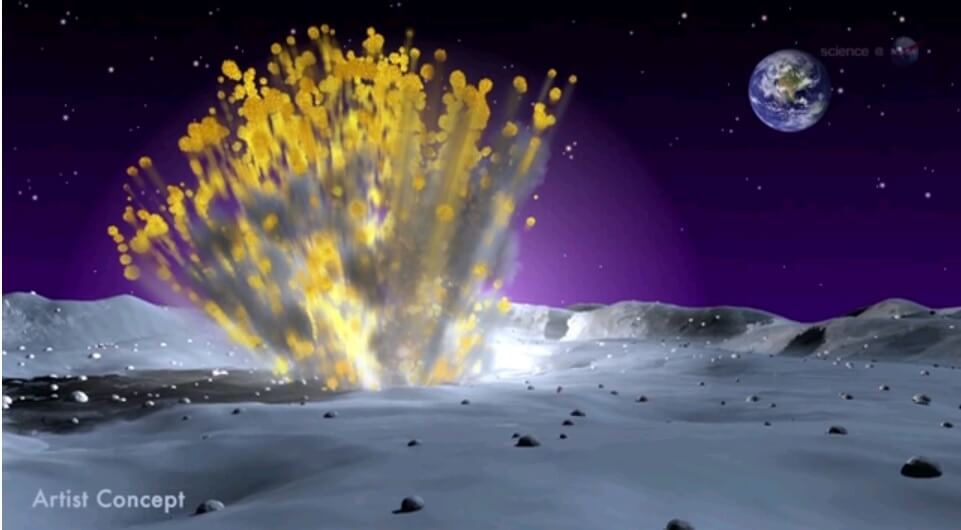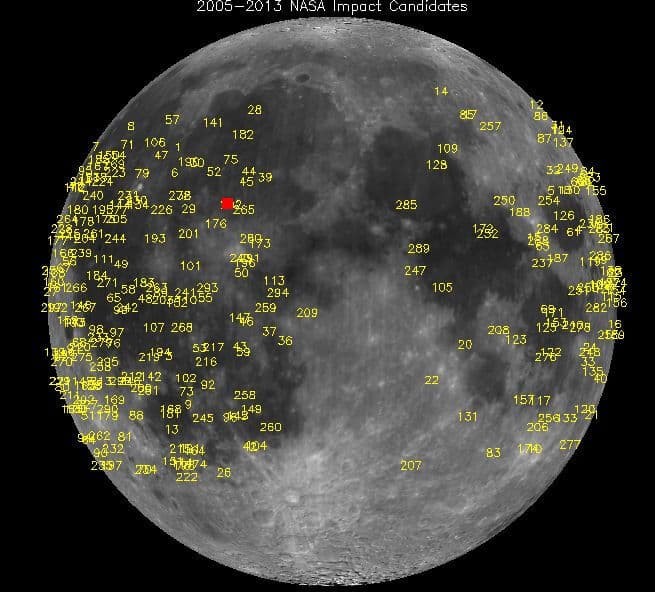NASA explains that the same streams of meteors from which come the meteor showers on Earth, also produce impacts on the moon, but none of them came close to the one observed on March 17, on that day there was also an unusual activity of meteors, outside of any known meter on a sphere. Country.

For the past eight years, NASA astronomers have been monitoring the Moon for signs of explosions caused by meteorites hitting the Moon's surface. "Moon meteorites" that turned out to be much more common than scientists thought - hundreds of such impacts occur every year. They recently encountered the largest meteorite explosion in the history of the show.
"On March 17, 2013, an object about the size of a small rock hit the surface of the Moon in the Imbrium Sea," says Bill Cook of NASA's Meteorite Office. "The meteor exploded in a flash 10 times brighter than any explosion we've seen before."
A video in the ScienceCast series that NASA uploaded to the website this weekend describes the meteor explosion on the moon from March 17, 2013.
Anyone watching the moon at the moment of impact could see the explosion - a telescope is not required for this purpose. For about one second, the flash was as bright as a star at magnitude 4.
Ron Suggs, of the Marshall Space Flight Center, was the first to notice the impact in a video taken by one of the monitoring program's 14-inch telescopes. "It jumped right out at me, it was so bright," he recalled.
A meteorite with a diameter of 30-40 centimeters hit the moon at a speed of 80 thousand km/h and exploded with the force of 5 tons of TNT.


Cook believes that the impact on the moon may be part of a much larger event.
"On the night of March 17-18, NASA and the University of Western Ontario photographed the entire sky and discovered an unusual number of meteors from deep space that hit the Earth's atmosphere," he says. "These fireballs all moved in an almost identical path between the Earth and the asteroid belt."
The Earth and therefore the Moon were hit by meteorites around the same time. "My working assumption is that the two events are related, and both are the result of a single clump of material settling in the Earth-Moon system," Cook says.
One of the goals of the lunar monitoring program is to identify new streams of rock and dust in space that pose a potential threat to the Earth and Moon system. The event from March 17 may be a good candidate.
NASA's Lunar Reconnaissance Orbiter detectors have already reported the impact. According to the detector data, the scientists estimate that the diameter of the resulting crater is about 20 meters, a width large enough to make it an easy target for the LRO spacecraft when it next passes over the impact site. Comparing the crater size to the brightness of the flash may give scientists a valuable real-time benchmark and help validate models of space rock impacts on the moon.
Unlike the Earth, which has an atmosphere to protect it, the Moon is airless and vulnerable to lunar meteorites crashing into the ground at high speed. Since the monitoring program began in 2005, NASA team members have identified over 300 impacts, most of which were orders of magnitude weaker than the March 17th event. Statistically, more than half of all meteors that hit the moon come from known meteorite streams such as the Leonid shower, while those that reach the Earth mostly burn up in the atmosphere. The rest are random meteors - fragments of comets and asteroids formed randomly.
Measuring the rate of impact of meteorites on the moon will make it possible to know whether future astronauts who will maintain a camp on the moon will be able to work on the lunar soil for a long time.
"We will monitor again and see if the phenomenon will return next year, when the Earth and Moon system will pass through the same area in space," says Cook. "In the meantime, we continue to analyze the event from March 17.

15 תגובות
I have often encountered (myself and others) this type of problem on an entire sequence of letters (as happened in this article) and it seems to me that spell checkers should try to discover such sequences.
The reason for the existence of such sequences is probably a small movement of the hand that causes all the letters it types to be shifted in the same way.
Error correction (not my spelling errors).
Google does not do the test on a whole word but on one letter or something like that.
Apparently on the phone it's more common because the keyboard there is small.
And those who didn't understand, then I am Gashd.
mich,
This is an app (and it only works for Android). I mentioned it, only because I use it and I know it works.
The fact that I said there are many of them - I came out a ton. Because I'd say there are a lot of them just based on the fact that I use it all the time.
Except that Google also does the same test.
4. Minus 4 is almost as bright as the sun.
to the site editor
4 or 4-magnitude star? I think it's minus 4?
Sho
Hmmm.. a white dot in space… it must be an alien spaceship and NASA is keeping it quiet…
XD
Traffic:
Maybe. I tried to read the documentation of Swiftkey and I didn't find such a feature there, but I had a long time to look for it.
mich,
There are already many such facilities…
(e.g. swift key)
Hi,
Resistance will not help!
Ami:
Biamtash=>in search
All letters in the middle are shifted one letter to the left on the keyboard.
I wonder if automatic mechanisms know how to suggest such corrections (a free idea for the various spellers 🙂 )
Read on Wikipedia and relax:
http://en.wikipedia.org/wiki/C/2012_S1
I'm in a panic - I can't keep quiet anymore and I have to share it with everyone!
C2012 - ISON discovered on 21.12.2012 will pass through the Earth's orbit if and when its orbit changes by 0.3%
It is expected to approach the Earth at the end of November this year - estimated November 26-28!
What do the astronomers say? Disagreement!
I checked and found countless places on the net where the comet is mentioned, but in all the places there is no mention of any scenario in which the comet will change its course, which is most likely to happen.
Can anyone reassure me?
It is recommended to use a spell checker. The first sentence finished me